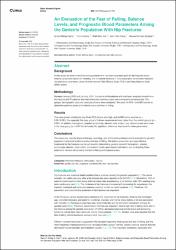An Evaluation of the Fear of Falling, Balance Levels, and Prognostic Blood Parameters Among the Geriatric Population With Hip Fractures

View/
Date
2022Author
Şahin, İsmail GökhanGültaç, Emre
Can, Fatih, İlker
Kılınç, Cam Yalın
Aydoğan, Nevres Hürriyet
Metadata
Show full item recordCitation
Şahın İ, Gültaç E, Can F, et al. (January 28, 2022) An Evaluation of the Fear of Falling, Balance Levels, and Prognostic Blood Parameters Among the Geriatric Population With Hip Fractures. Cureus 14(1): e21704. DOI 10.7759/cureus.21704.Abstract
Background
In this study, we determined that among patients who had been operated upon for hip fractures at our hospital, prognostic factors for mortality and functional recovery in the preoperative period were indicated via laboratory parameters using the International Falls Efficacy Scale (FES-I) and Berg Balance Scale (BBS) scores.
Methodology
Between January 2020 and January 2021, the results of 64 patients who had been surgically treated for a hip fracture and 57 patients who had scheduled elective surgery were compared retrospectively. The groups' demographic data and blood parameters were compared. We used the FES-I and BBS scores to determine patients' physical functional status and fear of falling.
Results
The case group's statistically significant FES-I score was high, and its BBS score was low (p = 0.001/0.001). As expected, the case group's D-dimer measurement was higher than the control group's (p = 0.001). In addition, hemoglobin, platelet, lymphocyte, albumin, total protein, and calcium levels were lower in the case group (p = 0.001 for all levels). No significant difference was found for other parameters.
Conclusions
The scales are used by physical therapy, neurology, and orthopedics professionals to evaluate the geriatric population's physical functional status and fear of falling. We believe prevention and cost-effective treatments for hip fractures can be achieved by determining geriatric patients' hemoglobin, platelet, lymphocyte, albumin, total protein, and calcium levels upon hospital admission and by directing these patients to relevant clinics using the fear-of-falling and balance scales.

















